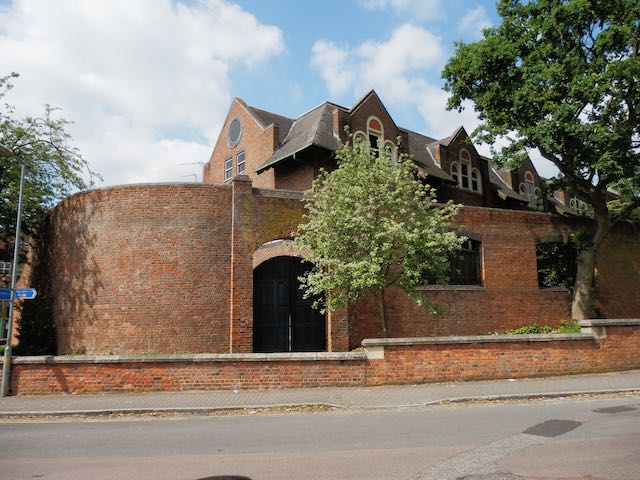Of all the prisoners at St Albans County Gaol during its half-century existence, that of Mary Ansell arguably attracted the most publicity. For the time, 1899, political, medical and social controversy ensured a widely covered debate over her fate.
We are presented with the case of two sisters, one of whom used the life of the other for her own gain. The brother of the sisters was also referred to by their father, but not of a further sister who also earlier died, leaving the parents with four children, all of whom pre-deceased them. Mary had no connection with St Albans, but it is her incarceration at the prison which brought her name to our attention.
Teenaged Caroline Ansell had been committed to the London Asylum Board's mental asylum at Leavesden, though there is little information about her condition or illness. At the time of the trial Caroline was 26 years old.
 |
| Leavesden Asylum |
Caroline shared the cake with a few other inmates, although she ate more than her friends – by ensuring her slice was much larger! The outcome was that, while her friends became ill, Caroline died. At the time there had been a typhoid outbreak at the asylum, so the staff took minimal notice of such an unusual death until an autopsy had revealed a case of poisoning.
Within a short time the parcel wrapping in which the cake had arrived was recovered, as was the rat poison, and the insurance policy document. The subsequent trial of Mary Ansell appeared to be straightforward, although a growing conversation in public ensured that for a time the outcome appeared uncertain. Among the voices was a body of around a hundred members of Parliament who were uneasy at being responsible for the state death of a young woman having, they believed, an uncertain state of mind. Petitions were also sent to the Home Secretary.
The Daily Mail, led a campaign in support of Mary and ran its own readers' petition. This did not succeed in overturning the court decision, and it also failed on the law pertaining to mental instability. [see extract below].
 |
| Mary Anne Ansell |
Even to the final moment Mary had firmly believed something would happen to save her from her fate, but her execution was carried out in St Albans, where about 2,000 members of the public gathered at the prison gates. The execution of women was by no means uncommon, around half of them for murder by poisoning. However, Mary was the youngest and the last to be hanged in the 19th century.
Mary's father is on record as stating "emphatically, there is no insanity in the family". As to Caroline, he held the belief that "she was as right as you are until her brother was killed, and she then fretted so much that her mind gave way."
For the completeness of this article, some years later an unidentified man came forward to confess to the poisoning of Caroline, which, if correct, would have proved Mary innocent, resulting in a miscarriage of justice; it would also have given an opportunity for the Daily Mail to state the newspaper was right all along. But this did not happen.
The Pall Mall Gazette (July 17th 1899) carried an extended editorial on the case:
Judge [Justice Mathew] expressed himself as absolutely convinced of the prisoner's guilt; on that point there cannot be two opinions. Clearer evidence, a more connected sequence in the stages of a crime have seldom been produced by counsel for the prosecution in a criminal case. The excuse now made for her, therefore, falls back on the argument that Mary Ansell is insane. Now madness, in the accepted sense of the word, implies an inability to calculate the results of actions. The poisoning of her imbecile sister was, on the contrary, one of the most deliberately contrived murders that are recorded in the annals of crime. The sending of the phosphorus through the post and the forging of the letter from her mother protesting against the post mortum examination, stamp it as a masterpiece of perverted calculation. Admitted to give evidence on her own behalf, she adopted the extremely devious line that she had insured her sister's life to give her a nice funeral, thereby appealing to what is a strong motive with the poorer classes, and the poorer they are the stronger it is. So far then as a capacity for coherent thought goes, Mary Ansel must be pronounced entirely responsible for her own actions and their terrible consequences.
The full editorial can be retrieved and viewed on the British Newspaper Archive.
A reporter from the Herts Advertiser was present outside the prison and noted attempts by individuals to gain a view of the scaffold from the railway embankment, but were removed by police officers. The bell of St Peter's Church rang, and the significant crowd remained subdued.
Thus completes the series of four accounts of three men and one woman whose lives were taken by the state at St Albans for the crimes they had committed. As indicated at beginning of the series their bodies were buried within the prison grounds directly after the hanging, but their remains were transferred to a common grave plot at Hatfield Road Cemetery in 1931.
 |
| The final resting place, to the left of the tree, of Charles Coleman, Thomas Wheeler, George Anderson and Mary Ansell. |






